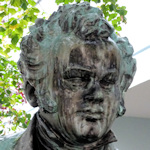
While the likes of Beethoven and Mozart were adopted sons of Vienna, Franz Schubert (1797-1828) was the city’s true biological offspring. Born here. Died here. And – for most of his short life – lived and worked here.
- Book a concert experience* for Vienna
- See also:
Explore the major (and minor) Schubert landmarks in Vienna using the map, notes, photos, and links below…
Schubert: his life
We begin, inevitably, at the beginning…
Schubert’s birthplace
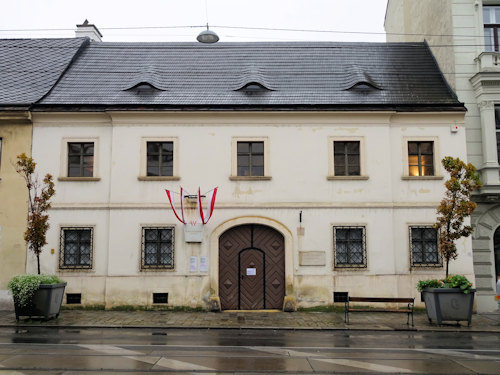
(Still the original house. Once in green suburbs, now deep in urban Vienna)
Schubert was born on Jan 31st, 1797 in the house at Nußdorfer Straße 54 in today’s Alsergrund district. He spent the early part of his childhood in what is now the Schubert Geburtshaus museum. It contains, for example, a pair of his famous spectacles.
A short walk takes you to two nearby sites featuring commemorative plaques…
Lichtentaler Pfarrkirche
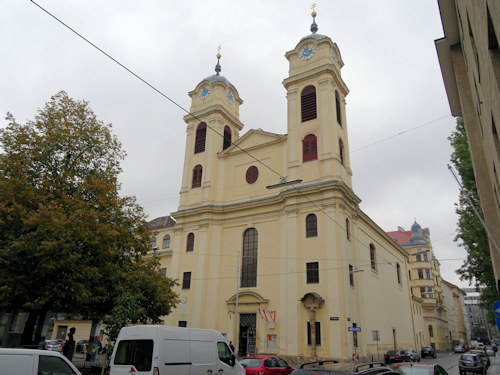
(The “Schubert church”)
The family baptised Schubert in this parish church, also known as the Schubertkirche.
Our bespectacled composer went on to sing in the choir, play the organ (which you can still see) and compose several works for the church.
Schubert wrote, for example, his Mass No. 1 in F major in celebration of the church’s centenary and conducted the first performance there on September 25, 1814.
The plaque commemorates the baptism and mentions Schubert’s artistic contribution to the church in both a practical and creative sense.
Säulengasse 3
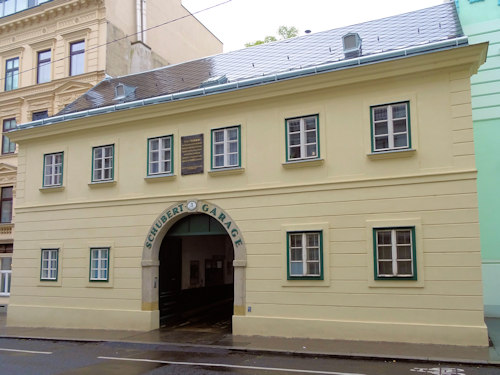
(Now a suitably-named garage)
Schubert lived over half his life in this residence, which also doubled as the parish church’s schoolhouse run by his father.
Here, Schubert apparently composed his 2nd, 3rd, 4th and 5th symphonies. Remarkably, the only things tuned there now are cars: despite the historical look, an auto repair shop occupies the premises inside.
The plaque says (my rough translation):
Franz Schubert lived in this house from 1801 for a long series of years. Here he worked as his father’s assistant teacher and created numerous immortal works, including the Erlkönig
Schools
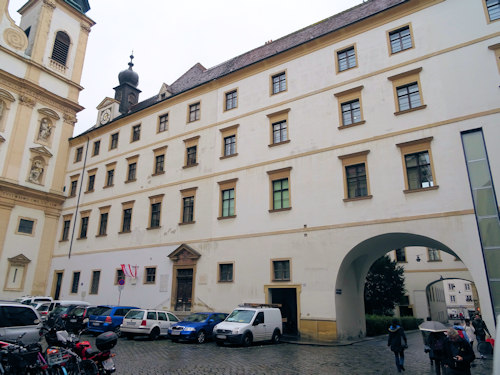
(The grammar school he attended)
Schubert attend the Akademische Gymnasium and Konviktschule grammar school on Dr.-Ignaz-Seipel-Platz. He was also a choir boy here, apparently taking lessons from none other than Antonio Salieri.
The beautiful old square also features the Jesuitenkirche (Jesuit church) and the Austrian Academy of Sciences. Walk the narrow lanes for a flavor of Vienna’s elegant past.
(No wonder they used the square in Season 3 of the Vienna Blood period detective series.)
Schubert did his teacher training at the St. Anna school (Annagasse 3-3a). The same building is where Austria’s most famous footballer – Matthias Sindelar – died in 1939, officially from accidental carbon monoxide poisoning but possibly at the hands of the Nazis.
Haunts
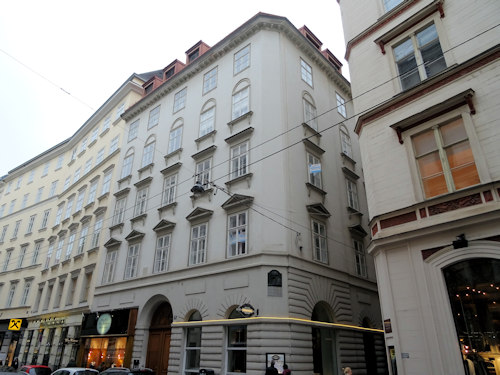
(Schubert began his unfinished symphony in this house)
Lacking funds, Schubert spent a large amount of time living in the apartments of friends like Franz von Schober (for example at Tuchlauben 14 and 20). Other addresses are marked on the map below, but among the more notable are:
- Spiegelgasse 9: von Schober’s home and creative birthplace of Schubert’s unfinished symphony

(Gasthof Zu den drei Hacken)
- Singerstraße 28: the restaurant at this address (“Zu den drei Hacken”) is one Schubert used to eat, drink and (presumably) compose in
Schubert’s place of death
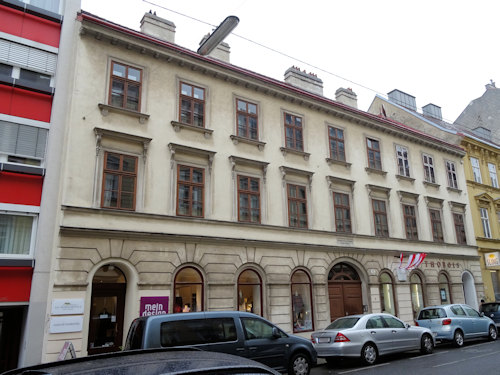
(Another original location cared for by the Wien Museum)
Schubert died on November 19, 1828 at Kettenbrückengasse 6 (his brother Ferdinand’s apartment). Like his birthplace, the Schubert Sterbewohnung is also a small museum.
Funeral church
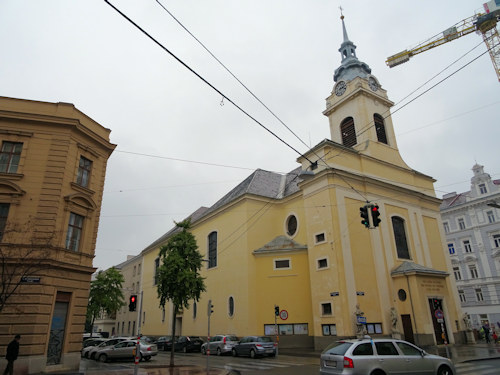
(The commemorative plaque is to the right of the main entrance)
The funeral service took place a few streets away at the St. Josef zu Margareten church at Schönbrunnerstraße 52, where you’ll find both a commemorative plaque and another church organ that Schubert used to play.
The plaque says (my rough translation):
Franz Schubert.
His body was blessed in this church on November 21st, 1828.
Wiener Schubertbund in the year 1928.
Währinger Schubertpark
They then buried Schubert close to Beethoven in the Währinger Ortsfriedhof (now a public park popular with dog owners and located at Teschnergasse / Schulgasse). However…
Schubert’s grave

(Schubert’s grave in the main cemetery)
Some years after Schubert’s death, the grave moved to the main Zentralfriedhof cemetery (as did Beethoven’s). They both joined other famous composers in what you might call a celebrity section: this is where you find Schubert’s grave today.
The original grave site in the Schubertpark still features the headstone monument erected by friends and family using funds raised by concert performances.
Schubert: his music
In addition to some of the locations mentioned earlier…
Alserkirche
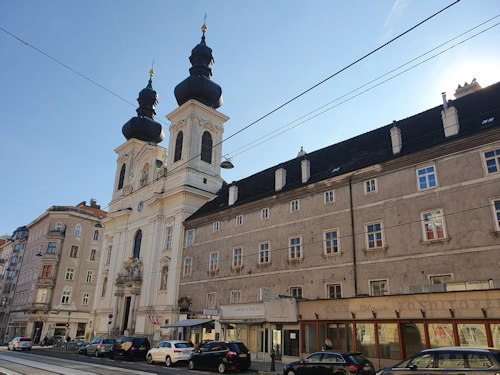
(Another one of Vienna’s many churches with famous musical connections)
Schubert wrote music for the Alserkirche church, and his Mass No.6 premiered here. A plaque outside marks the connection (my rough translation).
In September 1828, just a few weeks before his death, Franz Schubert wrote the hymn Glaube Hoffnung & Liebe for the inauguration of this church’s bells
The Alserkirche also hosted Beethoven’s funeral service.
Augarten Park
Schubert appeared with his piece The Nightingale on May 1, 1824 in the Augartensaal. A plaque outside the building mentions the event. The location now houses a restaurant and the Augarten Porcelain Museum.
Mozart and Beethoven also made appearances at the same venue.
Palais Niederösterreich
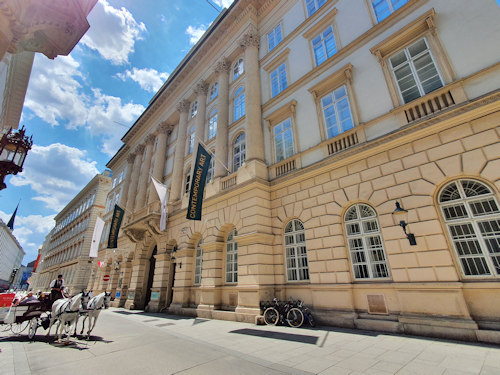
(The former seat of the government of Lower Austria)
This lovely town house dates back to Renaissance times, and Schubert premiered at least one of his works there (possibly Geist der Liebe in 1822).
Apparently, the location also witnessed performances by Beethoven and Liszt. Vienna in a nutshell.
Schubert: memorials & more
Schubert statue
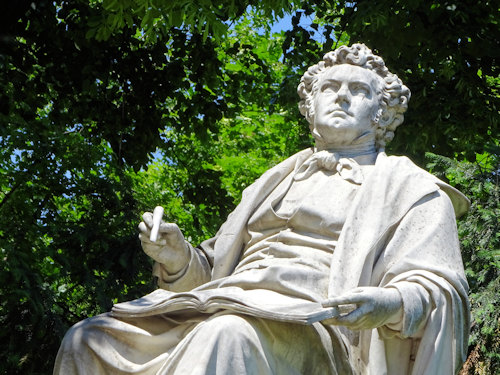
(Captured in the act of creation)
The central Stadtpark park has a Schubert statue, erected in 1872.
I like Schubert’s look: poised to put another inspirational note down on paper. The monument lacks the size and golden colour of the nearby Strauss memorial, which is why you won’t usually have to wait to take a photo.
Lime tree and memorial stone
Bruno-Kreisky Park (where the Margaretengürtel meets the Schönbrunner Straße) features a lime tree and memorial stone planted to mark the 100th anniversary of the composer’s death. What can I say about it? It’s a lime tree.
Schubert fountain

(OK, not Vienna’s most impressive fountain)
The Schubertbrunnen (at the junction of Alserbachstraße and Liechtensteinstraße) appeared in 1928. It rained when I visited. Fountains don’t look good in the rain.
Haus der Musik
Vienna’s museum of sound has a room dedicated to Schubert on its composer floor. Among the goodies within: another pair of his spectacles and a copy of the school register from 1809 featuring Schubert’s name.
Neue Burg
The instrument collection housed in the Neue Burg wing of the Hofburg Palace has a square piano that Schubert used and a portrait by Josef Abel from the early 1800s that most likely portrays the composer as a young man.
Enjoy your trip around Schubert’s Vienna and remember:
Anyone who loves music can never be quite unhappy